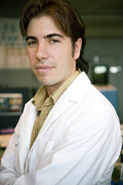Rock star geneticist
Tom Hudson's breakthrough code map

Tom Hudson's team charted out part of the HapMap.
Claudio Calligaris
"I have an anecdote to tell you," says Tom Hudson conspiratorially. On his way back from the American Society for Human Genetics annual meeting last month in Utah, Hudson found himself in an elevator with Rolling Stones guitarist Keith Richards.
A woman on one side of the elevator turned to the musician and asked, "Are you Keith Jagger?"
"He gave a little laugh and says 'half,'" Hudson says. "The elevator doors open again and a man with the Globe and Mail in his hands steps in. He looks at Keith Richards and looks at me and says, 'Wow! Two celebrities in the same elevator.'"
Keith Richards looked at Hudson, quizzically. "I'm just a scientist," Hudson says.
"So am I," came Richards' reply. "Everyone started laughing," says Hudson.
Hudson may not be a rock star, but the geneticist is no stranger to fame. As the director of the McGill University and Genome Quebec Innovation Centre, his most recent achievement — the one that landed his picture on the front page of the Globe and Mail — has been to track some of the millions of tiny differences in our genetic code that lead to disease.
"It is a major breakthrough for scientists. It's as significant as sequencing the human genome," says Hudson. "This is really a map to study the genetics of common diseases."
A little more than a year ago, scientists announced that they had decoded the complete sequence of the human genome, a long string of 3 billion letters — A, T, G, and C — representing the four bases of DNA. This genetic blueprint is nearly identical for every person. But 0.1 percent of this plan differs from person to person. These tiny changes, one letter here or there, give us different coloured hair or eyes, and influence our susceptibility to certain diseases that develop from a complex mélange of genetics and environment.
Scientists believe that there are about 10 million of these tiny one letter variations, or small nuclear polymorphisms (SNPs), in the human genome. (SNPs are commonly referred to as "snips.") Many of these genetic differences contribute to the onset of diseases like asthma, diabetes and colon cancer. They may also help scientists and pharmaceutical companies develop more tailored treatments.
Hudson is one of more than 200 international researchers who collaborated on this catalogue of genetic diversity, called the HapMap. The $128-million consortium was established in October 2002, and funded by Genome Canada, the U.S. National Human Genome Research Institute and the UK-based Wellcome Trust.

Research associate Alexandre Montpetit.
Claudio Calligaris
The project characterized one million SNPs in 269 volunteers from different ethnic backgrounds — Chinese, Nigerian, Japanese, and American with European ancestry. The Montreal team did about 10 percent of the genome in phase one, says Alexandre Montpetit, project leader and research associate at McGill. The team was assigned chromosome 2 and half of chromosome 4.
"There are disease genes on every chromosome," says Montpetit. "There is one gene for diabetes on chromosome 2 and another candidate for lupus, and we were working on those diseases at the time."
The HapMap is a powerful tool that will let scientists identify the pieces of the genome that are involved in different diseases. "Two or three years ago, we really didn't know how to comprehensively study a different region or candidate gene," says Montpetit. "Now we know exactly how to select the SNPs; there are fewer tests for us to do."
Researchers are already beginning to use the data. There are 10,000 accesses to the database each week, says Hudson. "Big labs are using the information. We are using the technology to find genes in colon cancer," he says, describing a research project called the Assessment of Risk for Colorectal Tumours in Canada (ARCTIC). The group has recruited 1,200 people with colon cancer and 1,200 without, and is comparing segments of the genome in affected and unaffected individuals. The project has an international scope and is the largest colon cancer genetics project in the world right now. "The next step will be screening people for tumours when these are still small and still curable. With colon cancer, most of the time people are too late, and the cure rate is below 50 percent. But if you pick it up early you can take it out, and the cure rate is over 95 percent."
In addition to the colon cancer detection project, Hudson's group has an asthma project that will pay close attention to environmental influences. Understanding the genetic variation may lead to better drugs that are specific to different subtypes of asthma.
"In the next two or three years we will be much more knowledgeable about the genetics of complex disease than we could imagine had this not happened," says Hudson.

